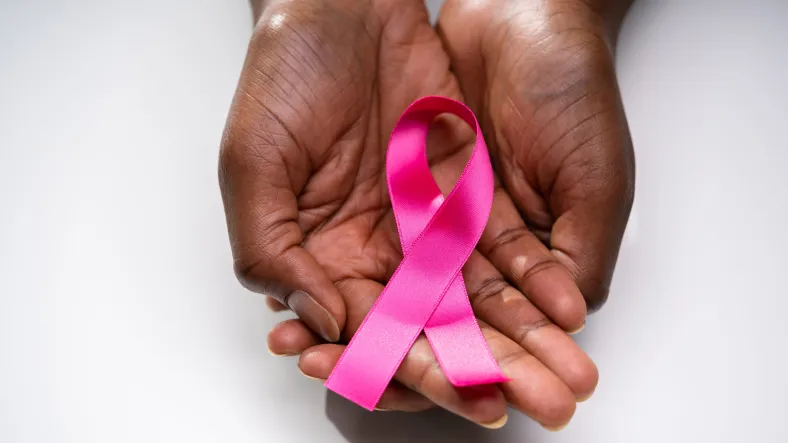

9 AM - 5 PM



Breast cancer is a type of cancer that starts in the breast. It starts when cells in the breast begin to grow out of control. Breast cancer cells usually form a tumor that can often be seen on an x-ray or felt as a lump. There are many types of breast cancer. Some are very rare.
How does the doctor know I have breast cancer?
A change seen on your mammogram may be the first sign of breast cancer. Or you may have found a lump or other change in your breast.
The doctor will ask you questions about your health and will do a physical exam. A breast exam is done to look for changes in the nipples or the skin of your breasts. The doctor will also check the lymph nodes under your arm and above your collarbone. Swollen or hard lymph nodes might mean breast cancer has spread there.
If signs are pointing to breast cancer, more tests will be done. Here are some of the tests you may need:
Mammogram: This is an x-ray of the breast. Mammograms are mostly used to find breast cancer early. But another mammogram might be done to look more closely at the breast problem you might have.
MRI scan: MRIs use radio waves and strong magnets instead of x-rays to make detailed pictures. MRIs can be used to learn more about the size of the cancer and look for other tumors in the breast.
Breast ultrasound: For this test, a small wand is moved around on your skin. It gives off sound waves and picks up the echoes as they bounce off tissues. The echoes are made into a picture that you can see on a computer screen. Ultrasound can help the doctor see if a lump is a fluid-filled cyst (which is not likely to be cancer), or if it's a tumor that could be cancer.
Nipple discharge exam: If you have fluid coming from your nipple, some of it may be sent to a lab. There, it will be checked to see if there are cancer cells in it.
If breast cancer is found, other tests, such as a CT (CAT) scan, PET scan, or bone scan might be done to look for cancer spread.
Breast biopsy, the doctor takes out small pieces of breast tissue to check them for cancer cells. A biopsy is the only way to tell for sure if you have breast cancer.
There are many types of biopsies. Each type has risks and benefits. The choice of which type to use depends on your own case.
Sometimes, surgery is needed to take out all or part of the lump to find out if it’s cancer. This is often done in a hospital using local anesthesia (numbing medicine). You might also be given medicine to make you sleepy.
If breast cancer is found on your biopsy, the cells will be checked for certain proteins or genes that will help the doctors decide how best to treat it.
If you have breast cancer, the doctor will want to find out how far it has spread. This is called staging. Your doctor will want to find out the stage of your cancer to help decide what type of treatment is best for you.
The stage describes the spread of the cancer through the breast. It also tells if the cancer has spread to other organs of your body that are close by or farther away. Your cancer can be stage 1, 2, 3, or 4. The lower the number, the less the cancer has spread. A higher number, like stage 4, means a more serious cancer that has spread beyond the breast.
What kind of treatment will I need?
There are many ways to treat breast cancer.
Surgery and radiation are used to treat cancer in a specific part of the body (such as the breast). They do not affect the rest of the body.
Chemotherapy, hormone treatment, targeted therapy, and immunotherapy drugs go through the whole body. They can reach cancer cells almost anywhere in the body.
Doctors often use more than one treatment for breast cancer. The treatment plan that’s best for you will depend on:
The cancer's stage and grade (how much the cancer cells look like normal cells)
If the cancer has specific proteins, like the HER2 protein or hormone receptors
The chance that a type of treatment will cure the cancer or help in some way: Your age, other health problems you have, your feelings about the treatment and the side effects that come with it.
You’ll be glad when treatment is over. For years after treatment ends, you will see your cancer doctor. Be sure to go to all of these follow-up visits. You will have exams, blood tests, and maybe other tests to see if the cancer has come back.
At first, your visits may be every few months. Then, the longer you’re cancer-free, the less often the visits are needed.
If you still have a breast (or part of one), you’ll need to get a mammogram every year. Depending on your treatment, you might need other tests as well, such as yearly pelvic exams or bone density tests.
Having cancer and dealing with treatment can be hard, but it can also be a time to look at your life in new ways. You might be thinking about how to improve your health. You can’t change the fact that you have cancer. What you can change is how you live the rest of your life – making healthy choices and feeling as well as you can.